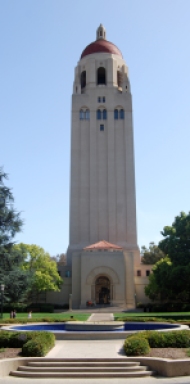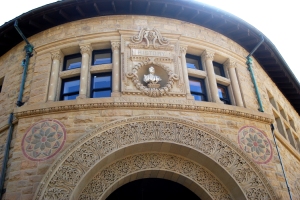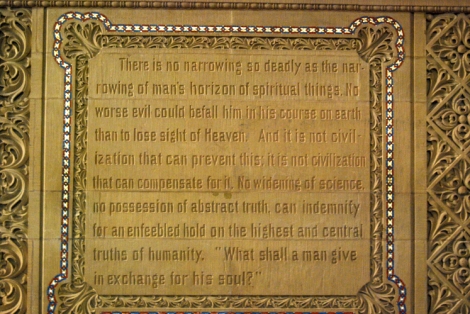In 1891, Stanford University opened its doors. The university, sometimes ranked along side the Ivy League, was created as a tribute to Leland and Jane Stanford’s only son who died of typhoid as a teenager. After visiting the Hanna House, which is owned by the university, my sister and I changed plans and ended up spending a little time on campus where we experienced what quickly became one of my favorite pieces of American religious architecture.
 When we arrived on campus, we quickly went to the Hoover Tower, part of the Hoover Institution on War, Revolution and Peace, which was created by the 31st U.S. President, Herbert Hoover, an alumnus of Stanford’s pioneer class. The tower was built in 1941 to celebrate the university’s quinquagenary or should I say golden jubilee and houses a carillon played on special occasions.
When we arrived on campus, we quickly went to the Hoover Tower, part of the Hoover Institution on War, Revolution and Peace, which was created by the 31st U.S. President, Herbert Hoover, an alumnus of Stanford’s pioneer class. The tower was built in 1941 to celebrate the university’s quinquagenary or should I say golden jubilee and houses a carillon played on special occasions.
From the top of the tower you get sweeping views for miles on a clear day. We could just make out the skyline of San Francisco and follow the water all the way down to San Jose. You also get a brilliant perspective of Stanford’s historic campus including our next destination at the heart of the school’s main quad—the Memorial Church.
I love visiting religious architecture. If you’ve followed my adventures for a while, you’ve seen posts about Buddhist temples and shrines, cathedrals, and of course LDS temples in addition to other religious sites. The devotion to something greater than oneself is manifested in these sacred spaces. Because of that devotion the architecture, the art, and the other details of these spaces are created with care, skill, quality and detail not found in most regularly used spaces.
After my visit, I would rank Stanford’s Memorial Church in my top three houses of worship in the United States, not including LDS temples, the others being Henry Hobson Richardson’s Trinity Church in Boston and the glorious Riverside Church in New York City. Granted there are many more I hope to experience, but these three spoke to me more than others.
This magnificent edifice is a very simple architectural design we might categorize as mission revival. The façade is adorned with a beautiful tile mosaic of Christ and his disciples. Inside there are other brilliant mosaics made of tiny ceramic squares, one is of Adam and Eve and the other depicts the prophets telling of Christ to come and Lucifer being cast from heaven. There are also four glorious angel mosaics surrounding the rotunda. Really though, any wall space that wasn’t a window or ornately carved stone was pretty much covered with mosaic tiles illustrating angelic ministrations and biblical scenes.
All around the church are vibrant stained-glass windows depicting stories of Jesus. My favorites are probably the three surrounding the altar at the front of the nave or the window portraying the Good Shepherd in the small side chapel at one end of the transept.
There are balconies on both sides and a magnificent organ loft at the rear with a stunning instrument. To hear that played would be glorious I’m sure. One of the more striking features of this building is the roof. On the inside you see its architecture of large wood beams spanning the hall in support of the massive building.
The Memorial Church was completed in 1903 as the final piece of the Stanfords’ vision for the campus a decade after Leland died and two years before his wife passed. The 1906 earthquake that devastated San Francisco and the whole area destroyed the church as the original central tower collapsed knocking down walls and exploding the mosaics and destroying the other glorious pieces of art.
After nearly a decade of rebuilding, the church reopened in 1917 in the iteration it is today. The 1989 earthquake also damaged the building though not nearly as bad as the first time, but as many other buildings in California, it received seismic upgrades to help it withstand the dancing of San Andreas in the future.
 My students in China would regularly make visiting university campuses a part of their travel itineraries. I always chuckled at this because I’ve never really sought out institutions for higher learning to visit as a tourist. My views of this have changed now after visiting Stanford. The architecture is stunning and holds surprises you may not find anywhere else. If only I had overcome this thought earlier in the day, we could have experienced the free museums and Rodin sculpture garden though we did see one Rodin sculpture in a quad near the church.
My students in China would regularly make visiting university campuses a part of their travel itineraries. I always chuckled at this because I’ve never really sought out institutions for higher learning to visit as a tourist. My views of this have changed now after visiting Stanford. The architecture is stunning and holds surprises you may not find anywhere else. If only I had overcome this thought earlier in the day, we could have experienced the free museums and Rodin sculpture garden though we did see one Rodin sculpture in a quad near the church.
As a closing thought to this post, here is one of the, for lack of a better word, stelae at the rear of the nave.






The Lu Life
Two of our good friends got married in the Standord church, and it was probably the most beautiful wedding ever! The architecture and art inside were just stunning!